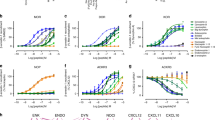Abstract
There is irrefutable proof that opioids and other classes of centrally acting drugs have profound effects on the immune system. Evidence is mounting that products of the immune system, such as chemokines, can reciprocally alter the actions of these drugs and the endogenous ligands for their receptors. Chemokines are a family of small (8 to 12 kDa) proteins involved in cellular migration and intercellular communication. With a few exceptions, they act on more than one receptor. Although the chemokines and their G protein-coupled receptors are located in both glia and neurons throughout the brain, they are not uniformly distributed. They are found in such brain areas as the hypothalamus, nucleus accumbens, limbic system, hippocampus, thalamus, cortex, and cerebellum. Among the chemokines differentially localized in brain neurons and glia are CCL2/MCP-1, CXCL12/SDF-1α, CX3CL1/fractalkine, CXCL10/IP 10, CCL3/MIP-1α, and CCL5/RANTES. Functional roles for the chemokine system, composed of the chemokine ligands and their receptors, have been suggested in brain development and heterologous desensitization. The system can alter the actions of neuronally active pharmacological agents such as opioids and cannabinoids and interact with neurotransmitter systems. In this review, we propose that the endogenous chemokine system in the brain acts in concert with the neurotransmitter and neuropeptide systems to govern brain function. It can thus be thought of as the third major system in the brain.
Similar content being viewed by others
References
Cooper JR, Bloom FE, Roth RH.The Biochemical Basis of Neuropharmacology. New York, NY. Oxford University Press; 2003.
Steward O.Functional Neuroscience. New York, NY: Springer-Verlag; 2000.
van der Meer P, Ulrich AM, González-Scarano F, Lavi E. Immunohistochemical analysis of CCR2, CCR3, CCR5, and CXCR4 in the human brain: potential mechanisms for HIV dementia.Exp Mol Pathol. 2000;69:192–201.
Banisadr G, Quéraud-Lesaux F, Boutterin MC, et al. Distribution, cellular localization and functional role of CCR2 chemokine receptors in adult rat brain.J Neurochem. 2002;81:257–269.
Ambrosini E, Aloisi F. Chemokines and glial cells: a complex network in the central nervous system.Neurochem Res. 2004;29:1017–1038.
Bajetto A, Bonavia R, Barbero S, Florio T, Schettini G. Chemokines and their receptors in the central nervous system.Front Neuroendocrinol. 2001;22:147–184.
Horuk R, Martin AW, Wang Z, et al. Expression of chemokine receptors by subsets of neurons in the central nervous system.J Immunol. 1997;158:2882–2890.
Coughlan CM, McManus CM, Sharron M, et al. Expression of multiple functional chemokine receptors and monocyte chemoattractant protein-1 in human neurons.Neuroscience. 2000;97:591–600.
Ji JF, He BP, Dheen ST, Tay SS. Expression of chemokine receptors CXCR4, CCR2, CCR5 and CX3CR1 in neural progenitor cells isolated from the subventricular zone of the adult rat brain.Neurosci Lett. 2004;355:236–240.
Banisadr G, Fontanges P, Haour F, Kitabgi P, Rostène W, Parsadaniantz SM. Neuroanatomical distribution of CXCR4 in adult rat brain and its localization in cholinergic and dopaminergic neurons.Eur J Neurosci. 2002;16:1661–1671.
Mizuno T, Kawanokuchi J, Numata K, Suzumura A. Production and neuroprotective function of fractalkine in the central nervous system.Brain Res. 2003;979:65–70.
Westmoreland SV, Alvarez X, deBakker C, et al. Developmental expression patterns of CCR5 and CXCR4 in the rhesus macaque brain.J Neuroimmunol. 2002;122:146–158.
Ragozzino D, Renzi M, Giovannelli A, Eusebi F. Stimulation of chemokine CXC receptor 4 induces synaptic depression of evoked parallel fibers inputs onto Purkinje neurons in mouse cerebellum.J Neuroimmunol. 2002;127:30–36.
Cho C, Miller RJ. Chemokine receptors and neural function.J Neurovirol. 2002;8:573–584.
Bajetto A, Bonavia R, Barbero S, Schettini G. Characterization of chemokines and their receptors in the central nervous system: physiopathological implications.J Neurochem. 2002;82:1311–1329.
Zheng J, Thylin MR, Ghorpade A, et al. Intracellular CXCR4 signaling, neuronal apoptosis and neuropathogenic mechanisms of HIV-1-associated dementia.J Neuroimmunol. 1999;98:185–200.
Stumm RK, Rummell J, Junker V, et al. A dual role for the SDF-1/CXCR4 chemokine receptor system in adult brain: isoform-selective regulation of SDF-1 expression modulates CXCR4-dependent neuronal plasticity and cerebral leukocyte recruitment after focal ischemia.J Neurosci. 2002;22:5865–5878.
Szabo I, Chen XH, Xin L, et al. Heterologous desensitization of opioid receptors by chemokines inhibits chemotaxis and enhances the perception of pain.Proc Natl Acad Sci USA. 2002;99:10276–10281.
Zhang N, Rogers TJ, Caterina M, Oppenheim JJ. Proinflammatory chemokines, such as C-C chemokine ligand 3, desensitize μ-opioid receptors on dorsal root ganglia neurons.J Immunol. 2004;173:594–599.
Steele AD, Szabo I, Bednar F, Rodgers RJ. Interactions between opioid and chemokine receptors: heterologous desensitization.Cytokine Growth Factor Rev. 2002;13:209–222.
Rogers TJ, Steele AD, Howard OMZ, Oppenheim JJ. Bidirectional heterologous desensitization of opioid and chemokine receptors.Ann N Y Acad Sci. 2000;917:19–28.
Szabo I, Wetzel MA, Zhang N, et al. Selective inactivation of CCR5 and decreased infectivity of R5 HIV-1 strains mediated by opioid-induced heterologous desensitization.J Leukoc Biol. 2003;74:1074–1082.
Pizziketti RJ, Pressman NS, Geller EB, Cowan A, Adler MW. Rat cold water tail-flick: a novel analgesic test that distinguishes opioid agonists from mixed agonist-antagonists.Eur J Pharmacol. 1985;119:23–29.
Chen C, Li J, Bot G, Szabo I, Rogers TJ, Liu-Chen L-Y. Heterodimerization and cross-desensitization between the μ-opioid receptor and the chemokine CCR5 receptor.Eur J Pharmacol. 2004;483:175–186.
Tran PB, Miller RJ. Chemokine receptors in the brain: a developing story.J Comp Neurol. 2003;457:1–6.
Rogers TJ, Peterson PK. Opioid G protein-coupled receptors: signals at the crossroads of inflammation.Trends Immunol. 2003;24:116–121.
Author information
Authors and Affiliations
Corresponding author
Additional information
Published: January 6, 2006
Rights and permissions
About this article
Cite this article
Adler, M.W., Geller, E.B., Chen, X. et al. Viewing chemokines as a third major system of communication in the brain. AAPS J 7, 84 (2005). https://doi.org/10.1208/aapsj070484
Received:
Accepted:
DOI: https://doi.org/10.1208/aapsj070484




